グレーデッドインデックス(GI)マルチモードファイバ
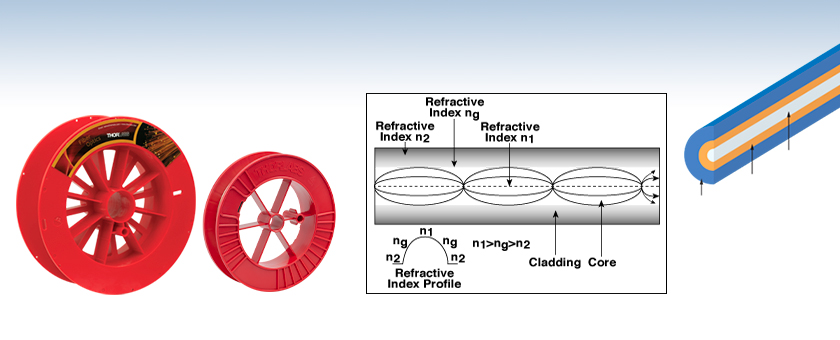
- Graded Refractive Index Profile Enables High Bandwidth
- Ø50 µm Core and Ø62.5 µm Core Options
- OM1, OM2, OM3, and OM4 Fibers Available
Graded-Index Multimode Fiber Cross Section
(Not to Scale)
Refractive Index Profile of Graded-Index Fiber
Acrylate Coating
Cladding
Germanium-
Doped Core
GIF50D
Graded-Index Fiber, Ø50 µm Core
GIF625-100
100-Meter Length of GIF625 Ø62.5 µm Core Fiber

Please Wait
| Stock Patch Cables Using This Fiber | |||
|---|---|---|---|
| Fiber Type | Connectors | Available Lengths | Patch Cable Item # |
| GIF625 | FC/PC | 1, 2, 3, 5, 10, 20 m | M31Lxx |
| GIF50C | FC/PC | 1, 2, 5 m | M115Lxx |
| GIF50E | FC/PC | 1, 2, 5 m | M116Lxx |
| GIF50E | FC/PC to LC/PC | 1, 2, 5 m | M117Lxx |
特長
- コア径Ø50 µm/クラッド径Ø125 µmおよびコア径Ø62.5 µm/クラッド径Ø125 µmのファイバをご用意
- コア径Ø50 µmのファイバについては、3種類の帯域幅(OM2、OM3またはOM4)をご用意(詳細については「仕様」タブをご覧ください)
- コア径Ø62.5 µmのファイバについては、100 mおよび1000 mの長さのスプールに巻いた製品をご用意
当社のグレーデッドインデックスマルチモードファイバは、従来のステップインデックス型のマルチモードファイバに比べてモード分散と曲げ損失が小さく、動作波長範囲は800~1600 nmと広くなっています(この波長範囲の減衰特性は「グラフ」タブでご覧いただけます)。こちらのファイバは、シングルモードファイバに比べてコアサイズが大きいため伝送容量が大きく、短距離通信網や高速通信用に使用されています。コアとクラッド間の屈折率勾配により使用する波長における帯域幅が決まります。
当社のコア径Ø50 µm/クラッド径Ø125 µmのグレーデッドインデックスファイバは優れた伝送速度を有し、帯域幅としては3種類(OM2、OM3またはOM4)をご用意しております。ファイバには機械的にストリップ可能なØ242 μmアクリルコーティングが施されています。 こちらのファイバは特に通信用に適しています。帯域幅は高性能な850 nmレーザーシステム用に最適化されています。850 nmまたは1300 nm のLEDも、帯域幅は狭くなりますが使用可能です(詳細については「仕様」タブをご覧ください)。
低損失、高帯域幅のコア径Ø62.5 µm/クラッド径Ø125 µmのグレーデッドインデックスファイバ(OM1)は、水、温度、および湿度についての厳しい環境からファイバを保護するために2層のアクリルコーティングを使用しています。ファイバGIF625は1 m単位で、または100 mあるいは1000 mの長さでスプールに巻いてご提供しております。
| Item # | GIF50C | GIF50D | GIF50E | GIF625 | |
|---|---|---|---|---|---|
| Geometrical and Physical Specifications | |||||
| Core Diameter | 50.0 ± 2.5 µm | 62.5 ± 2.5 µm | |||
| Cladding Diameter | 125.0 ± 1.0 µm | 125 ± 1 µm | |||
| Coating Diameter | 242 ± 5 µm | 245 ± 10 µm | |||
| Core Non-Circularity | ≤ 5% | ≤ 5% | |||
| Cladding Non-Circularity | ≤ 1.0% | ≤ 1% | |||
| Coating Non-Circularity | - | ≤ 5% | |||
| Core-Cladding Concentricitya | ≤ 1.5 µm | ≤ 1 µm | |||
| Coating-Cladding Concentricity | < 12 µm | ≤ 8 µm | |||
| Core Doping | Germanium | Germanium | |||
| Coating Material | Acrylate | Acrylate | |||
| Proof Test | ≥ 100 kpsi | ≥ 100 kpsi | |||
| Core Index | Proprietaryb | Proprietaryb | |||
| Cladding Index | Proprietaryb | Proprietaryb | |||
| Operating Temperature | -60 to 85 °C | -60 to 85 °C | |||
| Optical Specifications | |||||
| Operating Wavelength | 800 - 1600 nm | 800 - 1600 nm | |||
| Numerical Aperture | 0.200 ± 0.015 | 0.275 ± 0.015 | |||
| Optical Multimode (OM) Type | OM2 | OM3 | OM4 | OM1 | |
| Bandwidth | High-Performance EMB (@ 850 nm)c | 950 MHz•km | 2000 MHz•km | 4700 MHz•km | - |
| Overfilled Modal Bandwidthd | 700 MHz•km @ 850 nm 500 MHz•km @ 1300 nm | 1500 MHz•km @ 850 nm 500 MHz•km @ 1300 nm | 3500 MHz•km @ 850 nm 500 MHz•km @ 1300 nm | ≥ 200 MHz•km @ 850 nm ≥ 500 MHz•km @ 1300 nm | |
| Attenuation | ≤ 2.3 dB/km @ 850 nm ≤ 0.6 dB/km @1300 nm | ≤ 2.9 dB/km @ 850 nm ≤ 0.6 dB/km @ 1300 nm | |||
| Macrobend Attenuation | - | 100 Turns on a Ø75 mm Mandrel: ≤ 0.5 dB @ 850 nm and @ 1300 nm | |||
| Effective Group Index of Refraction | 1.482 @ 850 nm 1.477 @ 1300 nm | 1.496 @ 850 nm 1.491 @ 1300 nm | |||
| Zero Dispersion Wavelength | 1295 nm (Min) 1315 nm (Max) | 1320 nm (Min) 1365 nm (Max) | |||
| Zero Dispersion Slope | ≤ 0.101 ps/(nm2•km) | ≤ 0.11 ps/(nm2•km) | |||
| Quick Links |
|---|
| Damage at the Air / Glass Interface |
| Intrinsic Damage Threshold |
| Preparation and Handling of Optical Fibers |
レーザによる石英ファイバの損傷
このチュートリアルではコネクタ無し(素線)ファイバ、コネクタ付きファイバ、およびレーザ光源に接続するその他のファイバ部品に関連する損傷メカニズムを詳しく説明しています。そのメカニズムには、空気/ガラス界面(自由空間結合時、またはコネクタ使用時)ならびにファイバ内における損傷が含まれます。ファイバ素線、パッチケーブル、または溶融型カプラなどのファイバ部品の場合、損傷につながる複数の可能性(例:コネクタ、ファイバ端面、機器そのもの)があります。ファイバが対処できる最大パワーは、常にそれらの損傷メカニズムの中の最小の限界値以下に制限されます。
損傷閾値はスケーリング則や一般的なルールを用いて推定することはできますが、ファイバの損傷閾値の絶対値は利用方法やユーザ定義に大きく依存します。このガイドは、損傷リスクを最小に抑える安全なパワーレベルを推定するためにご利用いただくことができます。適切な準備と取扱い方法に関するガイドラインにすべて従えば、ファイバ部品は規定された最大パワーレベルで使うことができます。最大パワーの値が規定されていない場合は、部品を安全に使用するために下表の「実用的な安全レベル」の範囲に留めてご使用ください。 パワー処理能力を低下させ、ファイバ部品に損傷を与える可能性がある要因は、ファイバ結合時のミスアライメント、ファイバ端面の汚れ、あるいはファイバそのものの欠陥などですが、これらに限られるわけではありません。特定の用途におけるファイバのパワー処理能力に関するお問い合わせは当社までご連絡ください。
空気/ガラス界面における損傷
空気/ガラス界面ではいくつかの損傷メカニズムが存在する可能性があります。自由空間結合の時、またはコネクタで2本のファイバを結合した時、光はこの界面に入射します。高強度の光は端面を損傷し、ファイバのパワー処理能力の低下や恒久的な損傷につながる場合があります。コネクタ付きのファイバで、コネクタがエポキシ接着剤でファイバに固定されている場合、高強度の光によって発生した熱により接着剤が焼けて、ファイバ端面に残留物が残る可能性があります。
| Table 36C Estimated Optical Power Densities on Air / Glass Interfacea | ||
|---|---|---|
| Type | Theoretical Damage Thresholdb | Practical Safe Levelc |
| CW (Average Power) | ~1 MW/cm2 | ~250 kW/cm2 |
| 10 ns Pulsed (Peak Power) | ~5 GW/cm2 | ~1 GW/cm2 |
ファイバ素線端面での損傷メカニズム
ファイバ端面での損傷メカニズムはバルクの光学素子の場合と同様なモデル化ができ、UV溶融石英(UVFS)基板の標準的な損傷閾値を石英ファイバに当てはめることができます。しかしバルクの光学素子とは異なり、光ファイバの空気/ガラス界面においてこの問題に関係する表面積やビーム径は非常に小さく、特にシングルモードファイバの場合はそれが顕著です。 パワー密度が与えられたとき、ファイバに入射するパワーは、小さいビーム径に対しては小さくする必要があります。
Table 36Cでは光パワー密度に対する2つの閾値が記載されています。理論的な損傷閾値と「実用的な安全レベル」です。一般に、理論的損傷閾値は、ファイバ端面の状態も結合状態も非常に良いという条件で、損傷のリスク無しにファイバの端面に入射できる最大パワー密度の推定値を表しています。「実用的な安全レベル」のパワー密度は、ファイバ損傷のリスクが極めて小さくなる値を示しています。ファイバまたはファイバ部品をこの実用的な安全レベルを超えて使用することは可能ですが、その時は取扱い上の注意事項を適切に守り、使用前にローパワーで性能をテストする必要があります。
シングルモードの実効面積の計算
シングルモードファイバの実効面積は、モードフィールド径(MFD)、すなわちファイバ内の光が伝搬する部分の断面積によって定義されます。この面積にはファイバのコアとクラッドの一部が含まれます。シングルモードファイバとの結合効率を良くするためには、入射ビーム径をファイバのモードフィールド径に合致させなければなりません。
例として、シングルモードファイバSM400を400 nmで使用した時のモードフィールド径(MFD)は約Ø3 µmで、SMF-28 Ultraを1550 nmで使用したときのモードフィールド径(MFD)はØ10.5 µmです。これらのファイバの実効面積は下記の通り計算します。
SM400 Fiber: Area = Pi x (MFD/2)2 = Pi x (1.5 µm)2 = 7.07 µm2 = 7.07 x 10-8 cm2
SMF-28 Ultra Fiber: Area = Pi x (MFD/2)2 = Pi x (5.25 µm)2 = 86.6 µm2 = 8.66 x 10-7 cm2
ファイバ端面が対応できるパワーを推定するには、パワー密度に実効面積を乗じます。なおこの計算は均一な強度プロファイルを想定しています。しかしほとんどのレーザービームでは、シングルモード内でガウス分布を示すため、ビームの端よりも中央のパワー密度が高くなります。よって、これらの計算は損傷閾値または実用的安全レベルに対応するパワーとは若干異なることを考慮する必要があります。連続光源を想定して上記のパワー密度の推定値を使用すると、それぞれのパワーは下記のように求められます。
SM400 Fiber: 7.07 x 10-8 cm2 x 1 MW/cm2 = 7.1 x 10-8 MW = 71 mW (理論的損傷閾値)
7.07 x 10-8 cm2 x 250 kW/cm2 = 1.8 x 10-5 kW = 18 mW (実用的な安全レベル)
SMF-28 Ultra Fiber: 8.66 x 10-7 cm2 x 1 MW/cm2 = 8.7 x 10-7 MW = 870 mW (理論的損傷閾値)
8.66 x 10-7 cm2 x 250 kW/cm2 = 2.1 x 10-4 kW = 210 mW (実用的な安全レベル)
マルチモードの実効面積
マルチモードファイバの実効面積は、そのコア径によって定義されますが、一般にシングルモードファイバのMFDよりもはるかに大きくなります。当社では最適な結合を得るためにコア径のおよそ70~80%にビームを集光することをお勧めしています。マルチモードファイバでは実効面積が大きくなるほどファイバ端面でのパワー密度は下がるので、より大きな光パワー(通常キロワットオーダ)を入射しても損傷は生じません。
フェルール・コネクタ付きファイバに関する損傷メカニズム
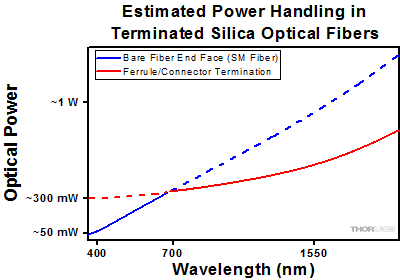 Click to Enlarge
Click to EnlargeFigure 36D コネクタ付きシングルモード石英ファイバに入力可能なパワー処理限界値(概算)を示したグラフ。各線はそれぞれの損傷メカニズムに応じたパワーレベルの推定値を示しています。入力可能な最大パワーは、損傷メカニズムごとに制限されるパワーのうちの一番小さな値(実線で表示)によって制限されます。
コネクタ付きファイバのパワー処理能力に関しては、ほかにも考慮すべき点があります。ファイバは通常、エポキシ接着剤でセラミック製またはスチール製のフェルールに取り付けられています。光がコネクタを通してファイバに結合されると、コアに入射せずにファイバを伝搬する光は散乱されてファイバの外層からフェルール内へ、さらにフェルール内でファイバを保持する接着剤へと伝搬します。光の強度が大きいとエポキシ接着剤が焼け、それが蒸発して残留物がコネクタ端面に付着します。これによりファイバ端面に局所的に光を吸収する部分ができ、それに伴って結合効率が減少して散乱が増加するため、さらなる損傷の原因となります。
エポキシ接着剤に関連する損傷は、いくつかの理由により波長に依存します。一般に、光の散乱は長波長よりも短波長で大きくなります。短波長用のMFDの小さなシングルモードファイバへの結合時には、ミスアライメントに伴ってより多くの散乱光が発生する可能性があります。
エポキシ樹脂が焼損するリスクを最小に抑えるために、ファイバ端面付近のファイバとフェルール間にエポキシ接着剤の無いエアギャップを有するファイバーコネクタを構築することができます。当社の高出力用マルチモードファイバーパッチケーブルでは、このような設計のコネクタを使用しております。
複数の損傷メカニズムがあるときのパワー処理限界値を求める方法
ファイバーケーブルまたはファイバ部品において複数の損傷要因がある場合(例:ファイバーパッチケーブル)、入力可能なパワーの最大値は必ずファイバ部品構成要素ごとの損傷閾値の中の一番小さな値により決まります。この値が一般的にはパッチケーブルの端面に入射可能な最大のパワーを表します(出力パワーではありません)。
Figure 36Dでは、シングルモードパッチケーブルにおけるファイバ端面での損傷とコネクタでの損傷に伴うパワー処理限界の推定値を例示しています。 ある波長におけるコネクタ付きファイバの総合的なパワー処理限界値は、その波長に対する2つの制限値の小さい方の値(実線)によって制限されます。488 nm付近で使用しているシングルモードファイバは主にファイバ端面の損傷(青い実線)によって制限されますが、1550 nmで使用しているファイバはコネクタの損傷(赤い実線)によって制限されます。
マルチモードファイバの実効面積はコア径で定義され、シングルモードファイバの実効面積より大きくなります。その結果、ファイバ端面のパワー密度が小さくなり、大きな光パワー(通常キロワットオーダ)を入射してもファイバに損傷は生じません(グラフには表示されていません)。しかし、フェルール・コネクタの損傷による限界値は変わらないため、マルチモードファイバが処理できる最大パワーはフェルールとコネクタによって制限されることになります。
上記の値は、取り扱いやアライメントが適切で、それらによる損傷が生じない場合のパワーレベルです。また、ファイバはここに記載されているパワーレベルを超えて使用されることもあります。しかし、そのような使い方をする場合は一般に専門的な知識が必要で、まずローパワーでテストして損傷のリスクを最小限に抑える必要があります。その場合においても、ハイパワーで使用するファイバ部品は消耗品と捉えた方が良いでしょう。
ファイバ内の損傷閾値
空気/ガラス界面で発生する損傷に加え、ファイバのパワー処理能力はファイバ内で発生する損傷メカニズムによっても制限されます。この制限はファイバ自体が本質的に有するもので、すべてのファイバ部品に適用されます。ファイバ内の損傷は、曲げ損失による損傷とフォトダークニングによる損傷の2つに分類されます。
曲げ損失
ファイバが鋭く曲げられると、コア内を伝搬する光がコア/クラッド界面において反射する際に、その反射角が全反射臨界角よりも大きくなります。曲げ損失は、このように内部全反射ができなくなることにより生じる損失です。このような状況下では、光はファイバから局所的に漏れだします。漏れる光のパワー密度は一般に大きく、ファイバのコーティングや補強チューブが焼損する可能性があります。
特殊ファイバに分類されるダブルクラッドファイバは、コアに加えてファイバのクラッド(2層目)も導波路として機能するため、曲げ損失による損傷のリスクが抑えられます。クラッドと被覆の界面の臨界角をコアとクラッドの界面の臨界角より大きくすることで、コアから漏れた光はクラッド内に緩く閉じ込められます。その後、光はセンチメートルからメートルオーダーの距離に渡って漏れ出しますが、局所的ではないため損傷リスクは最小に留められます。当社ではメガワットレベルの大きなパワーにも対応するNA 0.22のダブルクラッドマルチモードファイバを製造、販売しております。
フォトダークニング
もう1つのファイバ内の損傷メカニズムとして、特にコアにゲルマニウムが添加されたファイバをUVや短波長の可視光で使用した時に起こるフォトダークニングまたはソラリゼーションがあります。これらの波長で使用されたファイバは時間の経過とともに減衰量が増加します。 フォトダークニングが発生するメカニズムはほとんど分かっていませんが、その現象を緩和するファイバはいくつか開発されています。例えば、水酸イオン(OH)が非常に低いファイバはフォトダークニングに耐性があることが分かっています。またフッ化物などのほかの添加物もフォトダークニングを低減させる効果があります。
しかし、上記の対応をとったとしても、UV光や短波長に使用したファイバはいずれフォトダークニングが生じます。よってこれらの波長で使用するファイバは消耗品としてお考えください。
光ファイバの準備ならびに取扱い方法
一般的なクリーニングならびに操作ガイドライン
この一般的なクリーニングならびに操作ガイドラインはすべてのファイバ製品向けにお勧めしております。さらに付属資料やマニュアルに記載された個々の製品に特化したガイドラインも遵守してください。損傷閾値の計算は、すべてのクリーニングおよび取扱い手順に適切に従ったときにのみ適用することができます。
(コネクタ付き、またはファイバ素線に関わらず)ファイバを設置または組み込む前に、すべての光源はOFFにしてください。これにより、損傷の可能性のあるコネクタまたはファイバの脆弱な部分に集光されたビームが入射しないようにすることができます。
ファイバやコネクタ端面の品質がファイバのパワー処理能力に直結します。ファイバを光学系に接続する前に必ずファイバ端を点検してください。端面はきれいで、入射光の散乱を招く汚れや汚染物質があってはなりません。ファイバ素線は使用前にクリーブし、クリーブの状態が良好であることを確認するためにファイバ端面の点検をしてください。
ファイバを光学系に融着接続する場合、ハイパワーで使用する前にまずローパワーで融着接続の状態が良いことを確認してください。融着接続の品質が良くないと接続面での散乱が増え、ファイバ損傷の原因となる場合があります。
システムのアライメントや光結合の最適化などの作業はローパワーで行ってください。これによりファイバの(コア以外の)他の部分の露光が最小に抑えられます。ハイパワーのビームがクラッド、被覆またはコネクタに集光された場合、散乱光による損傷が発生する可能性があります。
ハイパワーでファイバを使用するための要点
光ファイバやファイバ部品は一般には安全なパワー限界値内で使用する必要がありますが、アライメントや端面のクリーニングがとても良い理想的な条件下では、ファイバ部品のパワー限界値を上げることができる場合があります。入力または出力パワーを増加させる前に、システム内のファイバ部品の性能と安定性を確認し、またすべての安全ならびに操作に関する指示に従わなければなりません。下記はファイバ内またはファイバ部品内の光パワーをの増大させること加を検討していするときに役立つご提案です。
ファイバースプライサを使用してファイバ部品をシステムに融着接続すると、空気/ファイバ界面での損傷の可能性を最小化できます。品質の高い融着接続が実現されるよう、すべて適切なガイドラインに則って実施する必要があります。融着接続の状態が悪いと、散乱や融着接続面での局所的な加熱などが発生し、ファイバを損傷する可能性があります。
ファイバまたはファイバ部品の接続後、ローパワーでシステムのテストやアライメントを実施してください。システムパワーを必要な出力パワーまで徐々に上昇させ、その間、定期的にすべての部品が適切にアライメントされ、結合効率が入力パワーによって変動していないことを確認します。
ファイバを鋭く曲げると曲げ損失が発生し、ファイバのストレスを受けた部分から光が漏れる可能性があります。ハイパワーで使用している時は、大量の光が小さな局所領域(歪みのある領域)から流出すると局所的に加熱され、ファイバが損傷する可能性があります。使用中はファイバの曲げが生じないよう配慮し、曲げ損失を最小限に抑えてください。
また、用途に適したファイバを選ぶことも損傷防止に役立ちます。例えば、ラージモードエリアファイバは、標準的なシングルモードファイバをハイパワー光用として用いる場合の良い代替品となります。優れたビーム品質を有しながらMFDも大きいため、空気/ファイバ界面でのパワー密度は小さくなります。
ステップインデックスシングルモード石英ファイバは、一般にUV光やピークパワーの大きなパルス光には使用しませんが、これはその用途に伴う空間パワー密度が大きいためです。
| Posted Comments: | |
Nural Akchurin
(posted 2025-07-28 15:49:42.85) Dear colleagues,
I am trying to get some attenuation data for GIF625 around 400-500 nm and compare it to more standard multimode fibers. Could you provide these data, if available please? I am interested in reduced propagation dispersion in the graded index fiber but I need to be able to operate in shorter wavelengths to capture and propagate Cherenkov photons. Thank you.
Nural Akchurin
Professor of Physics EGies
(posted 2025-08-14 04:54:53.0) Thank you for contacting Thorlabs. I have reached out to you directly regarding this. Additional specs and data can be requested by emailing techsupport@thorlabs.com. user
(posted 2025-07-09 09:43:08.13) Hi, I am interested in the index gradient constant of GIF50C. Could you please provide me with this info? Thanks in advance! EGies
(posted 2025-07-11 11:15:58.0) Thank you for contacting Thorlabs. Unfortunately, we do not have information on the gradient constant for GIF50C at this time. Additional specs and data can be requested by contacting techsupport@thorlabs.com. Andrew Lu
(posted 2025-04-16 10:26:15.953) Could you please provide gradient constant and central refractive index for GIF625? Many thanks! EGies
(posted 2025-04-17 12:46:23.0) Thank you for contacting Thorlabs. The central refractive index for GIF625 is proprietary, so I am unable to share this info. I have reached out to you directly regarding this and the gradient constant. BISHWAJYOTI DUTTA MAJUMDAR
(posted 2025-04-01 03:21:53.763) Please suggest suitable bare optical fiber for transmitting power of 10 watt at wavelength range 800 - 1600nm for laser ablation studies. We want to use these cables to make custom made SMA multi core termination for coupling with a GRIN lens followed by optical window at the end. cdolbashian
(posted 2025-04-22 01:05:14.0) Thank you for reaching out to us with this inquiry. For high-power handling, we would recommend end-capped fibers or High-power SMA connectors. I have contacted you directly to discuss your application further. Norbert Linz
(posted 2024-03-08 13:50:29.553) Can you please give me somer information regarding the pitch length for GIF625 when using 515 nm wavelength? cdolbashian
(posted 2024-03-15 04:57:18.0) Thank you for reaching out to us with this inquiry. Unfortunately we have limited data from the vendor, and it is only regarding the design wavelength of ~1300nm. I have contacted you directly to share this information with you. taywin witee
(posted 2023-10-05 19:57:22.54) ้Hi Sir / Madam
i will order GIF50E but i have some detail from you.
i want to know GIF50E have some material coating Cladding and Germanium-
Doped Core or not?
from the picture i think its have Acrylate Coating outside
so please you give me more detail or clear its for me
thanks
taywin w jpolaris
(posted 2023-10-05 01:15:27.0) Thank you for contacting Thorlabs. Yes, the core of GIF50E is Germanium-doped and the coating is acrylate. I have reached out to you directly to discuss this fiber in more detail. Jingwen Deng
(posted 2023-06-21 22:37:52.847) Hi,
I am interested in trying GRIN optical fiber for 660 - 750 nm wavelength transmission. I was wondering if you guys know the transmittance in this wavelength range. Thanks!
Best,
Jingwen jpolaris
(posted 2023-06-26 01:59:30.0) Thank you for contacting Thorlabs. Additional specifications and data can be requested by contacting techsupport@thorlabs.com. I have reached out to you directly with some relevant data. Radu Stancu
(posted 2023-01-18 14:14:46.993) Hi! Could you please let me know what is the gradient constant for the GIF625 fibre? Many thanks! jgreschler
(posted 2023-01-20 01:41:08.0) Thank you for reaching out to Thorlabs. Additional specs and data can be requested by emailing techsupport@thorlabs.com. I have reached out to you directly to provide the data. peter li
(posted 2022-11-20 01:27:34.233) what is dispersion v.s wavelength of GIF50E fiber? jgreschler
(posted 2022-11-22 08:16:09.0) Thank you for reaching out to Thorlabs. Additional specs and data can be requested by contacting techsupport@thorlabs.com. I have reached out to you directly to provide the requested graph. peter li
(posted 2022-11-20 01:26:23.477) what is dispersion v.s wavelength of GIF625 fiber? jgreschler
(posted 2022-11-22 08:16:10.0) Thank you for reaching out to Thorlabs. Additional specs and data can be requested by contacting techsupport@thorlabs.com. I have reached out to you directly to provide the requested graph. peter li
(posted 2022-11-19 23:12:12.26) If I use a spherical lens to couple this fiber,I based on this formula:f = D( πω/4λ),In order to couple light of wavelength λ、 beam of 1/e2 diameter D mode field diameter ω, choose a lens with a focal length f=7.5cm.
is this way possible to succesful couple? I want the coupling at lest 45%。
any suggestion?thanks! jgreschler
(posted 2022-11-22 08:16:11.0) Thank you for reaching out to Thorlabs. Spot size, and therefore coupling efficiency, rely on more factors than provided. General advice to attain good coupling efficiency is to use a small focal length aspheric lens, or an equivalent achromat if you are coupling broadband light. I have reached out to you directly to discuss your specific application further. Xu Jinggang
(posted 2022-09-07 18:47:09.35) For GIF625, could you provide the length of the pitch.I want to buy the full multiples of the pitch. jgreschler
(posted 2022-09-13 09:18:28.0) Thank you for reaching out to Thorlabs. The full pitch length of GIF625 at 1550 is approximately 1,052um. Chao Xu
(posted 2022-05-02 20:50:33.41) For GIF625, could you provide the formula coefficients of gradient constant and central refractive index? I mean the coefficients like K0,K1,K2, B, C.
Thank you. jgreschler
(posted 2022-05-05 03:42:49.0) Thank you for reaching out to Thorlabs. Additional data and specifications can be requested by emailing techsupport@thorlabs.com. I have contacted you directly to discuss your request. Pablo Fernández
(posted 2021-11-04 11:06:00.703) I am interested in seeing a plot conveying information on modal dispersion of GRIN-fiber. For example differential mode delay or range of light speed between main modes. (I am particularly interested on the relative delay between modes to see if I could use this over a single-mode fiber) jgreschler
(posted 2022-01-06 11:08:48.0) Thank you for reaching out to Thorlabs. Additional data can be requested by contacting Tech Support. I have reached out to you directly to discuss this further. cook0302
(posted 2019-03-07 22:42:13.927) Hello
I recently purchased some GIF625 and am trying to figure out the length to use to produce a 0.23 pitch lens. Are you able to advise on this at all? I am working around 1550nm.
Regards,
Peter Cook nbayconich
(posted 2019-03-15 08:39:21.0) Thank you for contacting Thorlabs. The estimated length need of GIF625 is about 263um to create a 0.23 pitch lens at 1550nm. etienne.genier
(posted 2019-01-24 12:42:51.68) Hello, would it be possible to have the refractive index profile and the gradient constant for the GIF50C and GIF625. YLohia
(posted 2019-01-29 10:32:50.0) Hello, I will reach out to you directly with the profile for GIF625. Unfortunately, we do not have this information for the GIF50C at the moment. nawid17
(posted 2018-11-07 14:20:25.063) Hello ! Would it be possible to have any kind of information (such as a profile) for the refractive index concerning gradient index fibers please ? YLohia
(posted 2018-11-07 10:29:33.0) Hello, please see my last response to your question. I will reach out to you directly with the data for GIF625 again. nawid17
(posted 2018-10-17 14:00:41.423) Hello ! Would it be possible to have the refractive index for the GIF50C; GIF50D and GIF50E profile please ? YLohia
(posted 2018-10-17 10:21:55.0) Hello, thank you for contacting Thorlabs. Unfortunately, the refractive index profiles for these three fibers is proprietary. That being said, we are still able to supply this information for the GIF625 if you are interested in that. We apologize for any inconvenience caused by this. xavier.attendu
(posted 2017-12-18 18:06:59.153) Hello. It would be very helpful to have the refractive index profile. Also, do you have any information regarding calculating the refractive index variation at different wavelengths (Sellmeier coefficients for example). Thanks in advance. nbayconich
(posted 2017-12-20 01:23:15.0) Thank you for contacting Thorlabs. We do not have the Sellmeier coefficients for this graded index fiber but I can provide the refractive index profile for you. I will reach out to you directly with more information. alexandreabid
(posted 2017-11-03 17:07:30.057) Hi I would need some infos on the GIF625 Grin lens. Could you send me the gradient constant as weel as the refractive index at 830nm?
I would also need the refractive index of your SM800 fiber. Thanks for your help. nbayconich
(posted 2017-12-15 04:58:31.0) Thank you for contacting Thorlabs. We do not have the gradient constant for the GIF625 but we can provide the refractive index profile for you. I will reach out to you directly with more information regarding the refractive index of GIF625 and SM800. ee14d209
(posted 2017-10-29 01:49:23.64) Dear,
May I know the dispersion value for GIF625 fiber at 1550nm. What does minimum zero dispersion value mean? tfrisch
(posted 2017-12-14 09:07:04.0) Hello, thank you for contacting Thorlabs. The material dispersion is about 21.5 ps/(nm km), and the Pulse Dispersion is about 0.78 ns/km at 1550nm. The actual value of the zero dispersion wavelength can change from one production lot to another, but it will be between 1320nm and 1365nm. I will reach out to you directly to discuss this in greater detail. chiwon.lee
(posted 2017-06-19 10:05:10.95) Hi, I'm wondering how much power can be handled with the GIF50C and GIF625 fiber. For example, my application needs to handle the laser pulse energy of 20 microjoule (peak power 10^8 W) with minimum modal dispersion, and I think this graded index fiber might be an safer option in terms of damage than single mode fiber. Thanks. tfrisch
(posted 2017-07-07 04:44:00.0) Hello, thank you for contacting Thorlabs. It looks like you are using a fs source, and while we don't have any formal damage threshold testing, I can reach out to you to discuss this application. In general, a larger core fiber will have a higher damage threshold, but keep in mind GIF fibers are multimode, so even though they have less modal dispersion than a step index multimode fiber, it will still be greater than a single mode fiber which only supports one mode. hamiltonpo
(posted 2017-06-01 12:43:00.217) Hello, could you please provide the refractive index profile of the GIF625? Thank you, Pearce. nbayconich
(posted 2017-06-14 09:42:41.0) Thank you for contacting Thorlabs. I will reach out to you directly with more information about the GIF625 index profile. honza.stopka
(posted 2016-06-30 05:13:54.037) Hello, could you please provide details on the refractive index profile of GIF625-10? I am using this fiber for my research for Master thesis. Thank you, Jan. nburgwin
(posted 2014-10-28 12:19:52.493) Can you provide any details on the refractive index profile of the GIF50C? This will be used for a research project.
Thanks,
Nick. jlow
(posted 2014-10-30 01:59:56.0) Response from Jeremy at Thorlabs: The index profile is considered proprietary information. I will contact you directly to discuss about this. dbs660
(posted 2014-10-22 11:01:03.993) Dear sir,
Could you provide me with the refractive index profile parameters of the GIF625 fiber?
thanks in advance,
Dirk jlow
(posted 2014-10-22 02:00:46.0) Response from Jeremy at Thorlab: We will contact you directly to provide this information. user
(posted 2014-07-09 05:07:46.677) Hello, I am using the fiber GIF50C. I would be pleased, if you could offer me the refractive index profile/gradient constant or alternatively the pitchlength at 1550 nm? Thanks and regards,
Yahua jlow
(posted 2014-08-07 09:08:22.0) Response from Jeremy at Thorlabs: We are not able to provide the refractive index profile for the GIF50C. ghohert
(posted 2014-03-31 13:47:34.757) Hi, I could use the refractive index profiles for GIF625 fiber. Thanks in advance. pbui
(posted 2014-04-02 04:13:33.0) We will contact you directly to provide the typical refractive index profile. christoph.otte
(posted 2013-08-27 14:42:53.097) Hello,
i'm using the fiber GIF50C and GIF625. I would be pleased, if you could offer me the refractive index profile/gradient constant or alternatively the pitchlength at 1300 nm?
Thanks a lot!
regards,
Christoph pbui
(posted 2013-08-29 14:23:00.0) Response from Phong at Thorlabs: We will contact you directly to provide these graphs. bpursley
(posted 2013-03-06 15:12:40.1) I currently have some gif625 and would like to use it at a wavelength of 2um if possible. Do you have attenuation data beyond 1600nm?
Thanks jlow
(posted 2013-03-08 17:03:00.0) Response from Jeremy at Thorlabs: We do not have any test data at this moment for the attenuation of this fiber at 2µm. We have a theoretical estimate that the attenuation would be around 0.7 dB/km at 2µm. tcohen
(posted 2012-11-07 17:53:54.617) Response from Tim at Thorlabs: Thank you for your feedback. We currently have limited data in the visible for these fibers. To access this data and receive updates while we look to extend our curves, please contact us at techsupport@thorlabs.com. user
(posted 2012-11-07 10:45:20.557) Can you add data for the attenuation across the visible, I have a number of wavelengths I'd like to transmit and can accept larger losses, but what to know approximately what to expect. jlow
(posted 2012-07-31 16:55:00.0) A response from Jeremy at Thorlabs: The typical pitch for the GIF625 fiber is around 0.986mm. The typical cladding/core(center) refractive index are about 1.45641/1.48585 (both at 656.20nm). xie
(posted 2012-07-31 12:08:06.0) Hi, I would like to know the pitch length (p) of GIF625 and the refractive index profiles of it. Thank you. tcohen
(posted 2012-06-21 15:29:00.0) Response from Tim at Thorlabs: Thank you for your interest in our graded index fibers! We are looking into the pitch for these fibers and have contacted you for more information on your application. edouard.schmidtlin
(posted 2012-06-18 17:25:07.0) Question about the grin media:
What is the pitch, or the NR2 Zemax coeffifient? tcohen
(posted 2012-05-17 11:42:00.0) Response from Tim at Thorlabs: Thank you for your feedback! We have moved the effective group index of refraction into the main presentation and I have contacted you with data on the index profile. jy_park
(posted 2012-05-16 02:01:20.0) Hi, recently I bought a spool of GIF625 & GIF50C for my experiment, but I can't find any information of index profiles. Please offer this data. Thanks:) jjurado
(posted 2011-09-05 21:27:00.0) Response from Javier at Thorlabs to dirk.lorenser: We will send you the refractive index profiles for the GIF625 and GIF50C fibers shortly. dirk.lorenser
(posted 2011-09-01 22:15:52.0) Hi I have GIF50C as well as GIF625 in our lab and I would like to know the refractive index profiles. I also need to know the diameter of the inner cladding (normally this is visible in refractive index profiles). Thanks. jjurado
(posted 2011-07-06 09:41:00.0) Response from Javier at Thorlabs to avle: Thank you very much for contacting us! I will send you plots of the refractive index for these fibers shortly. avle
(posted 2011-07-05 19:17:53.0) Hi there,
Do you have the refractive index profiles available for GIF 50 and GIF 625 optical fibers?
Thanks! jjurado
(posted 2011-02-11 11:09:00.0) Response from Javier at Thorlabs to last poster: Thank you very much for your feedback. The GIF50 and GIF625 fibers are doped with germanium in the core. This dopant raises the refractive index of the glass, which inherently slows down the speed of light traveling through the fiber. Also, trace amounts of phosphorous dopant are used to facilitate the deposition process in manufacturing. user
(posted 2011-02-08 10:44:47.0) Might be useful to spec the doping material used in this fiber. klee
(posted 2009-12-07 18:40:50.0) A response from Ken at Thorlabs to rajesh: The index profile was measured at 546nm. Unfortunately, the manufacturer cannot measure if at 488nm. rajesh
(posted 2009-12-02 07:55:02.0) The refractive index profiles are extremely useful. I have a couple of more questions regarding the refractive index profile of GIF625. Could you also mention the wavelength of light used for the measurement of the profile. I am interested to use the fibre at a wavelength of 488nm or close to 488nm. Could you kindly provide the index profiles at or close to 488nm.
Regards,
Rajesh Tyler
(posted 2009-01-26 08:20:29.0) A response from Tyler at Thorlabs to shalin: I forwarded your request to the technical support department last week. At which time, they informed me that your request was approved and that they would be contacting you for shipping information. I hope that these fiber samples help you in your research and if we can be of further assistance, please let us know. shalin
(posted 2009-01-21 04:11:50.0) Hello, I am from National University of Singapore. Could you please provide us a small length of GIF50 and GIF625 as a sample?
Thanks, Shalin (Graduate Student, Optical Bioimaging Lab). chenav
(posted 2008-12-16 12:55:34.0) Hello,
We are looking to purchase a spool of multi-mode, graded-index fiber for working at 532nm. We are especially interested in fibers with an allowed bending radius as low as possible. Please recommend which of your products would be best fit and add details on their bending radii.
Regards,
Chen Avinadav
Rafael Ltd. Laurie
(posted 2008-09-17 14:07:23.0) Response from Laurie at Thorlabs to hclee2: Thank you for our interest in our graded-index fiber. Someone from our technical support staff with be contacting you shortly with the requested information. In addition, we will add to the web information concerning the index of refraction as a function of radial distance in the very near future. hclee2
(posted 2008-09-15 10:29:48.0) Hi, I am interesting if you could provide the approximate refractive index distribution between n1, ng and n2 versus cross section distance. This informaion would be helpful for running this GIF in the simulation model to determine the appropriate length. Therefore, if there is any advanced infomation, please email to me. Thanks Laurie
(posted 2008-07-09 08:55:22.0) Response from Laurie at Thorlabs to wblee21: The GIF625HT will not work for the 200 - 800 nm wavelength range, but we have a new fiber that will be available soon (HPSC10) that covers the wavelength range from 280 to 750 nm. Unlike the GIF625HT, this new fiber will be a step-index fiber instead of a graded-index fiber. wblee21
(posted 2008-07-09 03:20:49.0) Can I use this GIF625HT for 200nm - 800nm also even if you mention this product operating wavelength 800-1350nm |
当社ではマルチモードファイバ素線を石英コア、フッ化ジルコニウム(ZrF4)コア、フッ化インジウム(InF3)コアでご用意しております。下の表には当社がご提供するマルチモードファイバ素線の詳細を掲載しています。表の右端の列のグラフのアイコンをクリックいただくと、損失のグラフをご覧いただけます。
| Index Profile | NA | Fiber Type | Item # | Core Size | Wavelength Range | Attenuation (Click for Graph) |
|---|---|---|---|---|---|---|
| Step Index | 0.100 | Enhanced Coating View These Fibers | FG010LDA | Ø10 µm | 400 to 550 nm and 700 to 1000 nm | |
| FG025LJA | Ø25 µm | 400 to 550 nm and 700 to 1400 nm | ||||
| FG105LVA | Ø105 µm | 400 to 2100 nm (Low OH) | ||||
| 0.22 | Standard Glass-Clad Silica View These Fibers | FG050UGA | Ø50 µm | 250 to 1200 nm (High OH) | ||
| FG105UCA | Ø105 µm | |||||
| FG200UEA | Ø200 µm | |||||
| FG400UEA | Ø400 µm | |||||
| FG600UEA | Ø600 µm | |||||
| FG1000UEA | Ø1000 µm | |||||
| FG050LGA | Ø50 µm | 400 to 2400 nm (Low OH) | ||||
| FG105LCA | Ø105 µm | |||||
| FG200LEA | Ø200 µm | |||||
| FG400LEA | Ø400 µm | |||||
| FG600LEA | Ø600 µm | |||||
| FG1000LEA | Ø1000 µm | |||||
| Polyimide Coating View These Fibers | FG100UEP | Ø100 µm | 250 to 1200 nm (High OH) | |||
| FG200UEP | Ø200 µm | |||||
| FG400UEP | Ø400 µm | |||||
| FG100LEP | Ø100 µm | 400 to 2400 nm (Low OH) | ||||
| FG200LEP | Ø200 µm | |||||
| FG400LEP | Ø400 µm | |||||
| Solarization Resistant for UV Use View These Fibers | FG105ACA | Ø105 µm | 180 to 1200 nm Acrylate Coating for Ease of Handling | |||
| FG200AEA | Ø200 µm | |||||
| FG300AEA | Ø300 µm | |||||
| FG400AEA | Ø400 µm | |||||
| FG600AEA | Ø600 µm | |||||
| UM22-100 | Ø100 µm | 180 to 850 nm Polyimide Coating for Use up to 300 °C | ||||
| UM22-200 | Ø200 µm | |||||
| UM22-300 | Ø300 µm | |||||
| UM22-400 | Ø400 µm | |||||
| UM22-600 | Ø600 µm | |||||
| High Power Double Clad View These Fibers | FG105UCE | Ø105 µm | 250 to 1200 nm (High OH) | |||
| FG200UCC | Ø200 µm | |||||
| FG273UEC | Ø273 µm | |||||
| FG365UEC | Ø365 µm | |||||
| FG550UEC | Ø550 µm | |||||
| FG910UEC | Ø910 µm | |||||
| FG105LCE | Ø105 µm | 400 to 2200 nm (Low OH) | ||||
| FG200LCC | Ø200 µm | |||||
| FG273LEC | Ø273 µm | |||||
| FG365LEC | Ø365 µm | |||||
| FG550LEC | Ø550 µm | |||||
| FG910LEC | Ø910 µm | |||||
| 0.39 | High Power TECS Cladding View These Fibers | FT200UMT | Ø200 µm | 300 to 1200 nm (High OH) | ||
| FT300UMT | Ø300 µm | |||||
| FT400UMT | Ø400 µm | |||||
| FT600UMT | Ø600 µm | |||||
| FT800UMT | Ø800 µm | |||||
| FT1000UMT | Ø1000 µm | |||||
| FT1500UMT | Ø1500 µm | |||||
| FT200EMT | Ø200 µm | 400 to 2200 nm (Low OH) | ||||
| FT300EMT | Ø300 µm | |||||
| FT400EMT | Ø400 µm | |||||
| FT600EMT | Ø600 µm | |||||
| FT800EMT | Ø800 µm | |||||
| FT1000EMT | Ø1000 µm | |||||
| FT1500EMT | Ø1500 µm | |||||
| 0.50 | Hard Polymer Cladding View These Fibers | FP200URT | Ø200 µm | 300 to 1200 nm (High OH) | ||
| FP400URT | Ø400 µm | |||||
| FP600URT | Ø600 µm | |||||
| FP1000URT | Ø1000 µm | |||||
| FP1500URT | Ø1500 µm | |||||
| FP200ERT | Ø200 µm | 400 to 2200 nm (Low OH) | ||||
| FP400ERT | Ø400 µm | |||||
| FP600ERT | Ø600 µm | |||||
| FP1000ERT | Ø1000 µm | |||||
| FP1500ERT | Ø1500 µm | |||||
| 0.20 | Zirconium Fluoride (ZrF4) Core for Mid-IR View These Fibers | Various Sizes Between Ø100 µm and Ø600 µm | 285 nm to 4.5 µm | |||
| 0.26 | Indium Fluoride (InF3) Core for Mid-IR View These Fibers | Ø100 µm | 310 nm to 5.5 µm | |||
| Graded Index | 0.20 | Graded Index for Low Bend Loss View These Fibers | GIF50C | Ø50 µm | 800 to 1600 nm | |
| GIF50D | ||||||
| GIF50E | ||||||
| 0.275 | GIF625 | Ø62.5 µm | 800 to 1600 nm | |||
 Products Home
Products Home








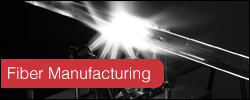
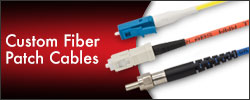
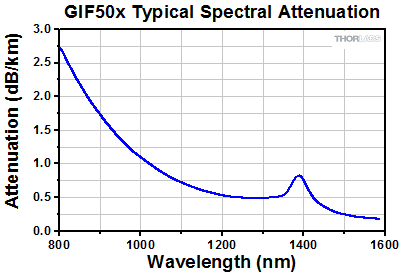
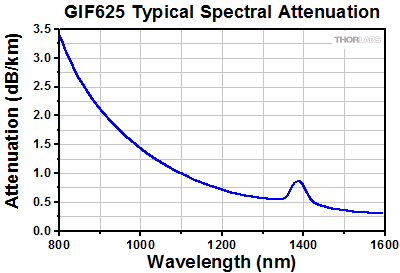
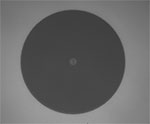
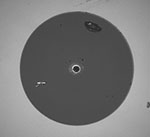

 マルチモードファイバ、グレーデッドインデックス(GI)
マルチモードファイバ、グレーデッドインデックス(GI)